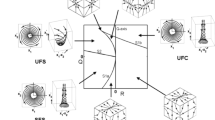Abstract
Within the framework of a weakly linear model, which describes a nonadiabatic flame near the limit of its propagation caused by heat losses, steady states of the combustion-wave from are studied. Three-dimensional structures of the wave front are formed because of diffusion-thermal instability of the planar flame. The limits of propagation of a curved flame front are shown to expand if the diffusion-thermal instability is taken into account: a cellular flame can exist at heat losses higher than the critical value for the two-dimensional flame. The stability of steady solutions, which describe the cellular flame near the limits of its propagation, is studied. For sufficiently high heat losses, steady solutions for a nonadiabatic flame with front discontinities are obtained.
Similar content being viewed by others
References
Ya. B. Zel’dovich, “Theory of the propagation limit for a quiet flame,”Zh. Éksp. Teor. Fiz.,11, No. 1, 159–168 (1941).
G. I. Barenblatt, Ya. B. Zel’dovich, and A. G. Istratov, “Diffusion-thermal instability of a laminar flame,”Prikl. Mekh. Tekh. Fiz., No. 4, 21–26 (1962).
G. Joulin and P. Clavin, “Linear stability analysis of nonadiabatic flames,”Combust. Flame,35, 139–153 (1979).
G. Joulin and G. I. Sivashinsky, “On the dynamics of nearly-extinguished nonadiabatic cellular flames,”Combust. Sci. Technol.,31, 79–90 (1983).
G. Joulin, “Shapes, velocities, and propagation limits of a nonadiabatic cellular flames,”Combust. Sci. Technol.,47, 69–79 (1986).
L. Kagan and G. I. Sivashinsky, “Self-fragmentation of non-adiabatic cellular flames,”Combust. Flame,108, 220–226 (1997).
C. W. Gear, “The automatic integration of ordinary differential equations,”Commun. ACM,14, No. 3, 176–179 (1971).
L. Sinay and F. A. Williams, “Stability of nonadiabatic cellular flames near extinction, in dynamics of gaseous combustion,” in: A. I. Kuhl, J.-C. Leyer, A. A. Borisov, and W. A. Sirignano (eds.),Progress in Astronautics and Aeronautics, Vol. 151, AIAA, Washington, DC (1993), pp. 263–273.
Author information
Authors and Affiliations
Additional information
Translated fromFizika Goreniya i Vzryva, Vol. 35, No. 4, pp. 3–11, July–August 1999.
Rights and permissions
About this article
Cite this article
Medvedev, A.E., Minaev, S.S. Steady states of the surface of a nonadiabatic flame near the limits. Combust Explos Shock Waves 35, 351–358 (1999). https://doi.org/10.1007/BF02674464
Received:
Revised:
Issue Date:
DOI: https://doi.org/10.1007/BF02674464



